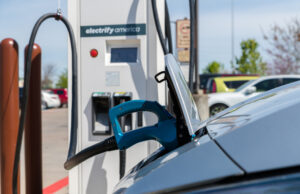
Switch to Tesla’s standard charging connector grows, SAE to standardize
By onTechnology
Electrify America has announced it will add Tesla’s North American Charging Standard (NACS) connector to its fast charging networks in the U.S. and Canada, and SAE International is working on standardizing NACS.
The Combined Charging System (CCS-1) connector will still be available as the transition is made to NACS, Electrify America said. The connector option is slated to be offered at each existing charging station and future ones by 2025.
Last week, SAE International shared that it will develop NACS standards, shortly after Ford, General Motors, Rivian, and Volvo made separate announcements that they would begin using NACS. Several states including Washington, Texas, and Kentucky have also mandated NACS in order for EV charging companies to receive money for charging infrastructure from a federally-funded state program.
According to Electrify America, several EV charging companies have also recently announced plans to adopt the NACS connector through adaptors or future products.
“Since our founding, we have focused on building an inclusive and open hyper-fast charging network to facilitate the adoption of electric vehicles,” said Robert Barrosa, president and CEO of Electrify America. “We look forward to continuing to support industry-wide standards that increase vehicle interoperability and streamline public charging.”
In addition to working with The Charging Interface Initiative (CharIN) and SAE International, Electrify America is participating in the newly created National Charging Experience Consortium (ChargeX), which will focus on strengthening the national charging infrastructure and improving the EV ownership experience.
Electrify America’s fast-charging network has more than 850 charging stations with nearly 4,000 individual chargers in the United States and Canada. Electrify America and Electrify Canada stations feature chargers at 150 kilowatts (kW) and 350kW.
SAE said standardization, in partnership with Tesla, is “the next step to establish a consensus-based approach for maintaining NACS and validating its ability to meet performance and interoperability criteria.”
The Joint Office of Energy and Transportation was instrumental in fostering the SAE-Tesla partnership and expediting plans to standardize NACS, SAE said. The initiative was also announced by the Biden Administration last week.
Along with the announcement, the National Renewable Energy Laboratory (NREL) released the 2030 National Charging Network study – a new analysis that quantifies the estimated number, type, and location of the chargers needed nationwide to support EV adoption.
The study was produced in collaboration with the Joint Office of Energy and Transportation and the U.S. Department of Energy’s Vehicle Technologies Office. It lays out charging infrastructure needs for light-duty EVs, including the effects of local variation in EV adoption, climate, travel patterns, housing, and charging preferences.
Key takeaways include:
-
- “The United States is on track to install a network of 1.2 million public chargers by 2030, keeping up with rapidly growing demand for EVs;
- “Of the 1.2 million charging ports, about 1 million are expected to be Level 2 charging providing convenient, low-cost charging to meet a variety of daily needs with the remaining charging ports being DC fast chargers that are critical to driver confidence and longer distance travel; and
- Building out this public charging network will require between $31 and $55 billion of cumulative public and private capital investment and will help unlock hundreds of billions of dollars of consumer savings from reduced fuel and maintenance costs.
Biden’s goal is to build out a national network of 500,000 charging stations.
Images
Featured image: A 2018 Nissan Leaf electric car plugged in at an Electrify America charging station in Pearland, Texas. (michelmond/iStock)
